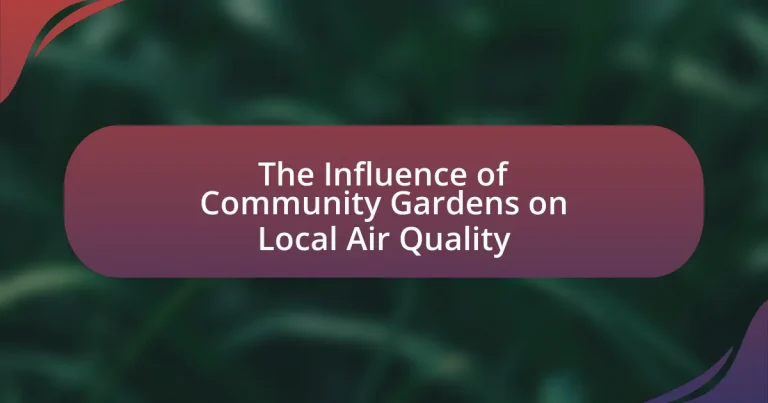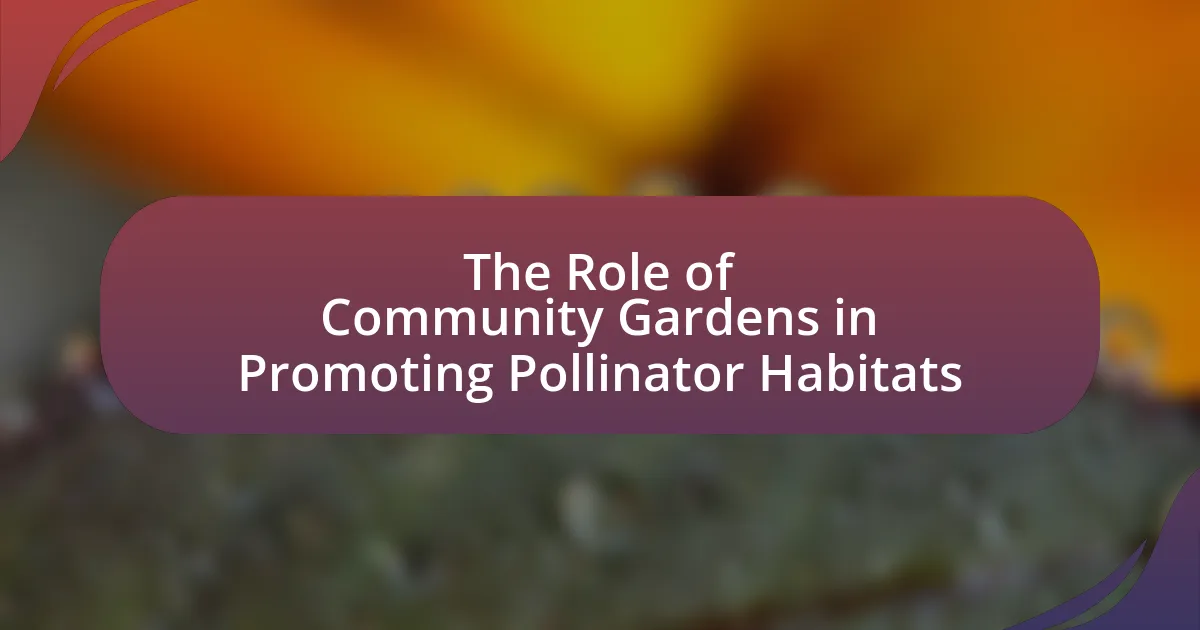Community gardens significantly influence local air quality by increasing vegetation, which enhances carbon dioxide absorption and oxygen production. Research indicates that these urban green spaces can reduce air pollutants, such as particulate matter and nitrogen dioxide, by up to 30%, thereby improving respiratory health for nearby residents. Additionally, community gardens foster biodiversity, lower local temperatures, and promote social engagement, all of which contribute to a healthier urban environment. The article explores the mechanisms through which community gardens filter air pollutants, the challenges they face, and practical steps for establishing and maintaining these gardens to optimize their air quality benefits.

What is the Influence of Community Gardens on Local Air Quality?
Community gardens positively influence local air quality by increasing vegetation, which enhances carbon dioxide absorption and oxygen production. Studies indicate that urban green spaces, including community gardens, can reduce air pollutants such as particulate matter and nitrogen dioxide. For instance, a research study published in the journal “Environmental Science & Technology” found that urban vegetation can lower air pollution levels by up to 30% in densely populated areas. This reduction in pollutants contributes to improved respiratory health and overall well-being for nearby residents.
How do community gardens contribute to improving air quality?
Community gardens contribute to improving air quality by increasing vegetation, which absorbs carbon dioxide and releases oxygen. This process enhances local air quality by reducing greenhouse gases and particulate matter. Studies indicate that urban green spaces, including community gardens, can lower air pollution levels by up to 30% in surrounding areas, as plants filter pollutants and improve overall atmospheric conditions.
What specific pollutants do community gardens help reduce?
Community gardens help reduce specific pollutants such as particulate matter (PM), nitrogen dioxide (NO2), and carbon dioxide (CO2). These gardens contribute to improved air quality by increasing vegetation, which absorbs CO2 and filters PM and NO2 from the air. Research indicates that urban green spaces, including community gardens, can lower PM levels by up to 30% in densely populated areas, thereby enhancing local air quality and promoting public health.
How do plants in community gardens filter air pollutants?
Plants in community gardens filter air pollutants through processes such as absorption, adsorption, and phytoremediation. These plants take up harmful gases like carbon dioxide and volatile organic compounds through their leaves and roots, effectively reducing their concentration in the air. For example, studies have shown that certain species can absorb particulate matter, which contributes to improved air quality. Additionally, plants release oxygen during photosynthesis, further enhancing the air quality in urban environments. Research indicates that urban vegetation, including community gardens, can significantly lower levels of pollutants, thereby benefiting public health and the environment.
Why are community gardens important for urban environments?
Community gardens are important for urban environments because they enhance air quality by increasing vegetation and reducing pollutants. The presence of plants in community gardens contributes to the absorption of carbon dioxide and the release of oxygen, which improves overall air quality. Research indicates that urban greenery, including community gardens, can lower particulate matter levels by up to 30%, thereby mitigating respiratory issues among city residents. Additionally, these gardens provide a habitat for pollinators and other wildlife, further promoting biodiversity and ecological balance in densely populated areas.
What role do community gardens play in enhancing urban biodiversity?
Community gardens play a crucial role in enhancing urban biodiversity by providing habitats for various species, including pollinators, birds, and beneficial insects. These gardens create green spaces that support diverse plant life, which in turn attracts wildlife and fosters ecological interactions. Research indicates that urban areas with community gardens exhibit higher species richness compared to those without, as these gardens serve as refuges for native flora and fauna. For instance, a study published in the journal “Urban Ecosystems” found that community gardens can increase local biodiversity by up to 30%, demonstrating their significant impact on urban ecosystems.
How do community gardens affect local temperature and humidity levels?
Community gardens lower local temperatures and increase humidity levels through the process of evapotranspiration and vegetation cover. The presence of plants in community gardens absorbs sunlight and provides shade, which can reduce the urban heat island effect, leading to cooler local temperatures. Additionally, plants release moisture into the air during transpiration, contributing to higher humidity levels in the surrounding area. Research indicates that urban green spaces, including community gardens, can reduce surface temperatures by up to 5 degrees Celsius compared to non-vegetated areas, while also enhancing local humidity by 10-20% due to increased moisture release from plants.
What are the social benefits of community gardens related to air quality?
Community gardens provide significant social benefits related to air quality by improving local environmental conditions and fostering community engagement. These gardens enhance air quality through the absorption of carbon dioxide and the release of oxygen, which contributes to a healthier atmosphere. Research indicates that urban greenery, including community gardens, can reduce air pollutants such as particulate matter and nitrogen dioxide, leading to improved respiratory health among residents. For instance, a study published in the journal “Environmental Science & Technology” found that urban vegetation can lower air pollution levels by up to 30%, demonstrating the direct impact of community gardens on air quality. Additionally, these gardens serve as communal spaces that promote social interaction and environmental awareness, further strengthening community ties and encouraging collective action towards sustainability.
How do community gardens foster community engagement and awareness about air quality?
Community gardens foster community engagement and awareness about air quality by providing a shared space for residents to collaborate on gardening activities, which encourages discussions about environmental issues. These gardens serve as educational platforms where participants learn about the benefits of plants in improving air quality, such as their ability to absorb pollutants and produce oxygen. Research indicates that urban green spaces, including community gardens, can reduce air pollution levels by up to 30% in surrounding areas, thereby raising awareness among community members about the importance of maintaining clean air. Additionally, community events and workshops held in these gardens often focus on sustainable practices that contribute to better air quality, further enhancing community involvement and knowledge.
What educational opportunities do community gardens provide regarding environmental health?
Community gardens provide educational opportunities regarding environmental health by teaching participants about sustainable practices, biodiversity, and the impact of urban agriculture on air quality. These gardens serve as hands-on learning environments where individuals can engage in activities such as composting, organic gardening, and pollinator habitat creation, which directly contribute to improved local air quality. Research indicates that urban green spaces, including community gardens, can reduce air pollution levels by absorbing pollutants and providing oxygen, thus enhancing community awareness of environmental stewardship and health benefits.
How can community gardens be optimized for better air quality?
Community gardens can be optimized for better air quality by incorporating a diverse range of plant species that are known to improve air filtration and increase oxygen production. Research indicates that plants such as trees, shrubs, and certain flowering plants can absorb pollutants like carbon dioxide, sulfur dioxide, and particulate matter, thereby enhancing local air quality. For instance, a study published in the journal “Environmental Science & Technology” found that urban greenery, including community gardens, can reduce air pollution levels by up to 30% in densely populated areas. Additionally, implementing practices such as organic gardening and avoiding chemical pesticides can further minimize harmful emissions and promote a healthier ecosystem.
What challenges do community gardens face in urban settings?
Community gardens in urban settings face several challenges, including limited access to land, soil contamination, and conflicts with local regulations. Limited access to land often results from high real estate prices and competing interests for urban space, making it difficult for communities to secure plots for gardening. Soil contamination is a significant concern, as urban areas may have polluted soil that poses health risks to gardeners and consumers. Additionally, local regulations can restrict gardening activities, such as zoning laws that limit the use of land for agricultural purposes. These challenges hinder the establishment and sustainability of community gardens, impacting their potential benefits for local air quality and community well-being.
How can urban planners support community gardens to enhance air quality?
Urban planners can support community gardens to enhance air quality by integrating them into urban design and policy frameworks. By allocating land specifically for community gardens, planners can increase green spaces that absorb pollutants and produce oxygen. Research indicates that urban vegetation can reduce particulate matter by up to 30%, significantly improving air quality. Additionally, planners can provide resources such as funding, technical assistance, and educational programs to empower communities in establishing and maintaining these gardens. This multifaceted approach not only promotes biodiversity but also fosters community engagement, leading to healthier urban environments.
What practical steps can communities take to establish effective community gardens?
Communities can establish effective community gardens by first identifying a suitable location that receives adequate sunlight and has access to water. This foundational step is crucial as it ensures the garden can thrive. Next, communities should engage local residents through meetings to gather input and build interest, fostering a sense of ownership and collaboration.
Following this, forming a garden committee can help organize tasks, manage resources, and maintain the garden. Securing funding or resources through grants, donations, or partnerships with local organizations can provide necessary financial support. Additionally, creating a plan that outlines the types of plants to grow, gardening techniques, and maintenance schedules will enhance the garden’s productivity.
Implementing educational workshops on gardening practices can empower community members with knowledge and skills, further promoting sustainability. Lastly, establishing rules and guidelines for garden use ensures equitable access and fosters a respectful community environment. These steps are supported by studies indicating that well-organized community gardens improve local air quality by increasing green space and promoting biodiversity.
What resources are available for starting a community garden focused on air quality improvement?
Resources for starting a community garden focused on air quality improvement include local government grants, nonprofit organizations, and educational programs. Local governments often provide funding and support for community gardens through environmental initiatives aimed at improving air quality. Nonprofit organizations, such as the American Community Gardening Association, offer resources, networking opportunities, and best practices for establishing gardens that enhance urban air quality. Additionally, educational programs from universities and environmental groups can provide training on plant selection and garden management that specifically targets air quality benefits, such as choosing species known for their air-purifying properties.
How can community members collaborate to maintain and improve air quality through gardening?
Community members can collaborate to maintain and improve air quality through gardening by establishing community gardens that utilize native plants and trees, which are known to absorb pollutants and produce oxygen. By working together to plant, maintain, and expand these gardens, community members can create green spaces that enhance air quality. Research indicates that urban greenery can reduce particulate matter and improve overall air quality; for example, a study published in the journal “Environmental Science & Technology” found that urban vegetation can lower air pollution levels by up to 30%. Additionally, community members can organize workshops to educate each other on sustainable gardening practices, such as composting and organic gardening, which further contribute to healthier air by minimizing chemical use.




